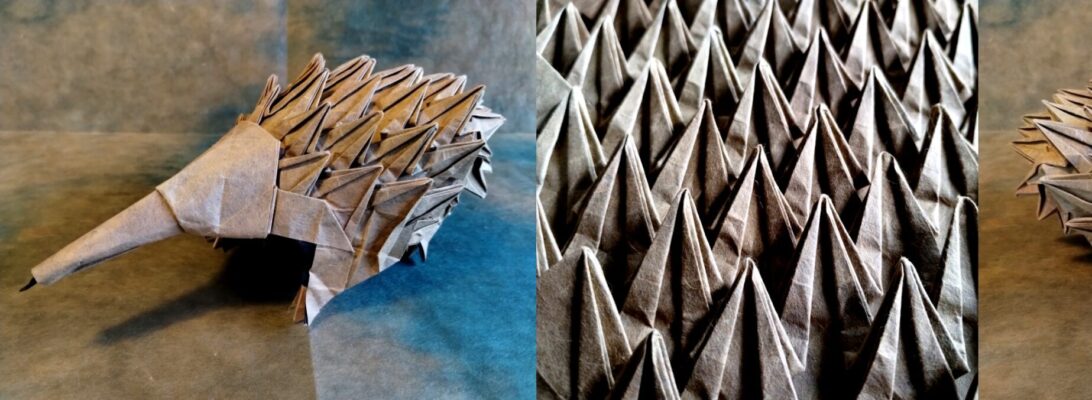I love a clever conceptual fold, and “Emptyhead” designed by Boice Wong (origamibyboice) is a clever example of art designed to make you think:

The first of these models – “Emptyhead I” is a lovely character that has an empty box sitting on his shoulders for a head. This model, uses a variation of the original CP (crease pattern), and represents his dumber brother completely detaching his head from his shoulders.

The original, as folded by Boice, has a solid cube for a head, but I Macgyvered a scheme to make it an open 2x2x2 cube instead, so he is clearly related to his more sensible brother.
From a 32 grid, this model cleverly presents shoes, cuffed pants, dress shirt, tie, collar, overcoat with lapels, 1 regular arm and one extra long arm, part of which becomes the box head. Such a neat design, the paper cleans itself up and provides wraps to make the seams tidy on the arms also. All this with no cuts, folds only. I did resort to using a few white glue spots to keep seams and layers in place, but tried to keep it as au-naturel as it was possible while being able to pose him for archival purposes.

I must admit to obsessing about this version, having solved the CP for the first version fairly quickly (which really surprised me if I am honest). I just assumed this version would let me make the free box head, but as I discovered, turning the long pleated tube into an open-ended box, when there was so little paper was a major issue.

I made a number of maquettes of the area in an effort to discover an acceptable scheme – originally I was going to have him actually “tipping” his brain out of the now empty box, but I did not have enough paper to turn the box on it’s edge and have it look good, so stumbled across a hinged pleated solution to allow the box to sit nicely on the palm of the stylised hand, and match the pose with the free arm. The open box at the top completes the family resemblance.

Folded from 55cm crispy Kraft paper, both figures are the same size and look very cute together. I bought some “Action Figure Stands” off Amazon and they work great as displays (must order some more, they are useful for models that are not free-standing). For the “heads-off” version I added some wire to the arms to ensure they keep their pose (without and the arms drooped, lowering the box onto his shoulders).

I have enjoyed this CP solving series and, given there are LOTS of models that only exist as CPs, not step diagrams, it is a skill I am determined to improve to widen the base of models I can try.
Once again I am amazed by the Interwebs, and how inter-connected it lets you be. Being able to reach out to the actual designer and swap ideas is just wonderful, and I thank Boice for his encouragement – a gentle balance of ensuring I do it myself, but getting feedback as I make breakthroughs and fuck-up.

I have had another folder INSIST I show them how I did the fold, and I find that uncomfortable at times, as I am not good at saying no, but must get better. Trying, fucking up and learning why the fuck up occurs is an important part of learning how to approach a problem – getting the solution without any experiential effort teaches you nothing but dependence.


I do love the satisfaction of solving a crease pattern. Im not so concerned about ‘dependence’ on more detailed instructions. It origami not unemployment benefit or opiates. Although I do seem to remember Margaret Thatcher being concerned that origami instructions might cause widespread idolence.
True, I increase my indolence as often as I can – there is a different challenge to solving CPs and then working how to shape from there – I like it, and am getting better at it.